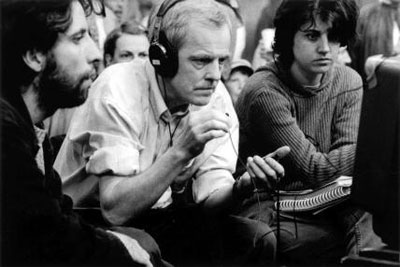 |
Peter Watkins |
If we talk about political cinema, Peter Watkins is perhaps the most representative polished and consistent, that is, one who has not only addressed issues head-on 'urgent' on the political (war, nuclear power, the role of media in the development of consensus), but it did so by forcing the same codes of filmmaking, before inventing genres which later became successful as the docu-drama and the mockumentary, then criticizing both the movies with his theoretical reflections the 'entire media industry. And 'perhaps odd that an intellectual like this, among other things, an Oscar winner, is kept well away from Italy? Apart from the sporadic distribution of film in just two films, a series monograph on TV in the summer of 1980 (in prime time on Rai 1: really old times!), And a book published two years ago on his class mass-political analysis ( The disappearance of German universal clock A. Duarte), Watkins remains an unknown in our country. But perhaps never before in recent years in which the relationship between media and power in Italy has shown its most ferocious, Watkins's reflections are important, as it would be useful to circulate his last film, the real mosaic not only libertarian or complaints, but powerful enemy and front of each power system.
Born in England in 1935, Peter Watkins has already made its debut in 1964, Culloden, a giant leap: a television drama commissioned by the BBC, which had to recall the last pitched battle fought on British soil in 1746. Watkins Culloden tears by the memory of the musty pages of history, "inventing" the docu-drama: that part of the reconstruction of the historical event in a setting like a television news report. Always with the camera on his shoulder, moving frantically on the battlefield, including interviews 'in drive' to officers, soldiers and poor peasants of 700 (all non-professional actors, constant feature in all his films), and ran to escape the gunfire or cannon, Watkins enters the event viewer as if the atrocities of the battle was going on at that time and not two centuries earlier. Suddenly, Culloden creates a short circuit with amazing images of the war in Vietnam who were in those months in the homes of English through television, suddenly, the deaths of 700 Scots were the frightened face of Vietnamese farmers, suddenly, the undo decades of film reconstructions of battles to present something new: the war in the making at that very moment, in the eyes of a Telereporter who dodges bullets and interview soldiers terrified of a sudden, the absurdity of that war becomes that of all wars, and the "responsibility" falls directly on the viewer who is watching.
The following year, Watkins raises its game, both on content and technique. No longer docu-drama, The War Game, also commissioned by the BBC, opens the way for the mockumentary, a fake documentary. The director envisions a nuclear bomb on England from the Soviets, and always describes his style telegiornalistico with shoulder camera and interviews. The film is shocking and the government blocks them from airing the first episode of a long history of calls and complaints from Watkins suffered everywhere: too dangerous to make the audience reflect on the arms race, too embarrassing to hear statements true and accurate data reported incongruously under the explosions, too extreme descriptions of the collapse of society, with radiation, the destruction of all infrastructure and the police firing on the people to contain the unrest. Despite winning the Academy Award in the category (with even more political move involuntarily) of 'documentaries' and despite the wide distribution (it became a cult in the campus revolt of Americans in that period and ushered in the cult of' hand-held camera), The War Game was banned from British television for over twenty years, and in our country came in 1984 with the Ark, with "War Time.
The straw that broke the camel's back of the relations between Watkins and England, and that the director had to leave forever his country, was the first film conceived directly for the cinema: Privilege (1966), the only other work of Watkins distributed in Italy. Here the theme moves on interaction between power and the increasingly rampant youth pop culture, that England had just re-launched with the Beatles and the rise of subcultures from trendy mods to rockers. The protagonist of the film is a singer 'rebel', cajoled and finally swallowed by the big powers, not only politically, but also the religious and economic. So the pop star (played by a real singer, Paul Jones) is found to be a mere puppet in the hands of those who want to convey to the masses of young people through a sham rebellion towards consensus and approval.
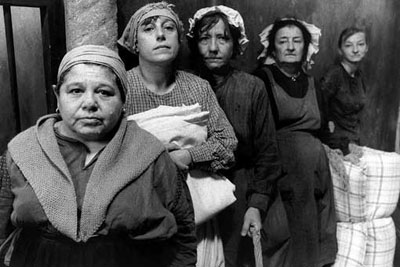 |
La Commune |
 The grotesque face of power The grotesque face of power
In 1969, Watkins made in Sweden Gladiators, one of the most bitter allegories film about the war. In this sci-fi utopia, the world is pacified and conveys the aggression war in Olympics: General and heads of state gather in a control room, arranging the troops (in true real battlefields) to mo 'driving distance of Risk and . They, the powerful, warm and get compliments on the 'move' others, 'gladiators' in the trenches, to die. The war, in close relationship with the actuality of Vietnam, is a target on which Watkins obsessive landing right back in the U.S., where in 1970 he realizes the awesome Punishment park. In the film, the American peace activists are confined in a camp in the desert and subjected to a mock trial at the end of which they are invited to a game: run into the desert to freedom, but being chased by the soldiers who will kill them. Hunting deadly to the Pacific, in short, that is the face of the grotesque state of emergency instituted by Nixon to counter the domestic context. Imagine the reactions of the establishment in front of this film in which the mechanisms of cinema-verite documentary of the fake and plunge into an allegory that delivers a harsh indictment of the repression of freedom.
He returned to Sweden, signing Watkins Edvard Munch (1973), a biographical film about the painter. Apparently far from his usual themes, allows the director to not only weave an extensive correspondence with the contemporary, but also to experiment with new creative: lots of dialogue, in fact, are improvised by the actors (also non-professional). The experiment will be repeated later with a biography of Strindberg, even more radical in creative ways, called The Freethinker (1994) and the now almost usual outcome of films banned on television.
After a film directed analysis of contemporary society (The Seventies People of 1974 on suicide among young Danish), the new target is nuclear power, with a country at sunset (1976), one of the more extreme and ruthless of Watkins. The film imagines that the workers of the shipyard strike in Copenhagen fall blocking the construction of a submarine designed to carry nuclear missiles. The strike, police repression, the ambiguities of power, the terrorist groups who kidnap political leaders: a truly impressive crescendo of stimuli and offending, well summed up by what one critic wrote: "When you learn to stop scaring Watkins the public? ". The film picked up an almost unanimous chorus of attacks from the conservative press as from the left accusing the director of siding with the terrorists rather than the workers. Needless to mention the fact that a project is activated immediately after the RAI in 1977 for a film about Marinetti was immediately aborted.
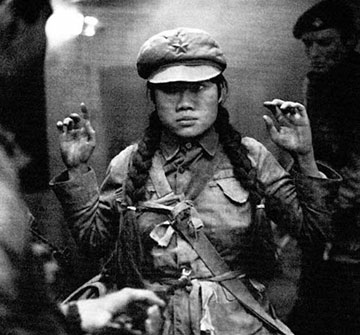 |
The gladiators |
 For an overview "Participated" For an overview "Participated"
The next project, The Journey (1986), is sensational, not only for the duration of the film (14 hours). This is the first film "global", filmed in many parts of the world including Europe, America and Australia, and the denunciation of war and nuclear weapons, in particular the role of media in the falsification and manipulation of information: film strictly independent, since that every request for production was denied at every latitude, and substantially in the anarchist conception of the construction in which dozens of people actively working together in a common mode of collective creation. The purpose of the film is to show how people in each country is held totally unaware of the dangers that threaten peace. E 'therefore become the system of communication, the real target of attack by Watkins: lens that will focus more and more in subsequent years and will have a new important success in his most recent film, shot in 1999. It's La Commune (Paris 1871), or almost 6 hours (but shot in two weeks where there were old studies Méliès) to tell a key event in European history, Watkins seen as essential to starting the reading of the Western world contemporary. Hence the need to involve non-professional actors in the preparation of the film, through studies and research that each of them had been called to do on his own, also improvised during filming. From this experience comes Rebond the association since 2000, given the substantial yet another boycott of this film on traditional channels of distribution, projections and works to promote new and experimental modes of vision "shared" the film itself.
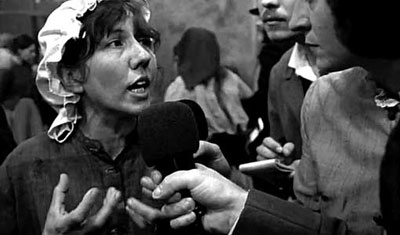 |
La Commune |
The greater commitment of Watkins in recent decades is mainly theoretical and pedagogical. Focal point of his reflection is critical to the media identified as manipulation of information in favor of a political system aimed at the consolidation of economic power and its most important means of supporting the war. In particular, much of its effort is aimed at revealing the mechanisms of what he called the "single size" real approval code of the media system, which led to the crisis of contemporary communication. A key point of this concept is the development and establishment of a single dominant mode of 'story', a form-repetitive language, a real format, born and raised in Hollywood with the double-instrument global American film and television. The single size crushed the opportunity for reflection by the viewer through the use of predetermined plot lines now and 'intentions' in the reception, which allows the producer of communication to predetermine the type of reaction from the viewer. Alternatively, if no real antidote to the spread of these forms of control consent, the search for modalities (film and television) capable of disrupting the mechanisms of a single size, on the other hand, has nothing to do with political goodwill of the producer of audiovisual aids. Not surprisingly, the English director considers single size attributable to his own films until 1976, ie including its own way politically perhaps more shocking, a village at sunset. The experiment of breaking the single size, in an attempt to create different and creative dynamics of political involvement "real" of all, even trying to reset the internal mechanisms of power to the team making the film, is accomplished only by Watkins from The Journey that is, since he conceived the film is created by a basic input from many people, with an equally widespread awareness and sharing. Up to the Commune, for which even includes an innovative method for receiving (and thus awareness) by the viewer.
The complexity of this work, the difficulty of distribution and the same difficulty trying to focus a viewer in the vision of his latest works from the time the river and constantly surprising narrative, shows just how our addiction to single size of viewers complained to Watkins has come almost to the point of no return. The challenge is high and although the search for Watkins will always be marginal (as seems to be the place where he went to live for years, Lithuania) and the mainstream media, remains in all of us the strength to know that a Another type of political cinema and media policy is possible.
 Stefano Casi
Stefano Casi
The crisis of mass-media
by Peter Watkins
At a conference held last year in France, the director says his own conception of media. And as opposed to their pervasiveness.
Since the time of the ban by the BBC in 1966 of my film The War Game (who spoke of the consequences of the use of nuclear weapons) I have dealt with the growing demote Mavm (Mass Media AudioVisual, audio-visual media) and the development of what we now call "the crisis of the media." Key elements of this crisis: the agenda of Mavm heavily circumscribed, forced the development of popular culture media, the standardization of audiovisual form which results in creating a relationship with the public increasingly hierarchical and manipulative, and education systems largely subdued this system.
In the mid-70s I had two summer courses at James Shenton of Columbia University in New York, where we analyzed a series of programs of American news. Hence arose my awareness of what I call a single size, which I have written extensively for over 30 years.
Our research at Columbia showed the development of a form-language television formatted and repetitive, consisting of mounted images quickly and fragmented, accompanied by a heavy bombardment of sound, all held together by classical narrative structure. Although this form-language was originally conceived by Hollywood, it was disturbing to discover its common use by virtually all contemporary television programming, from soap operas to news broadcasts. This standardization - and the logic behind that - has deteriorated in recent decades, and now encompasses virtually all forms of use of film and television work, including truth-tv, sports programs, most of the documentaries, etc..
Because of its extremely fast (especially the version developed in the last 20 years), the single size does not give time interaction, reflection or questions. The dense layering of sound and the lack of silence (except for purposes manipulators) are hostile to reflection. The images are mounted rapidly as small passenger cars, and the tracks run on the narrative structure monolinear as originally developed by Hollywood and plotted to move the story (the message) on a predetermined line (from producers, not the public) to get in between points of impact until the final climax and conclusion.
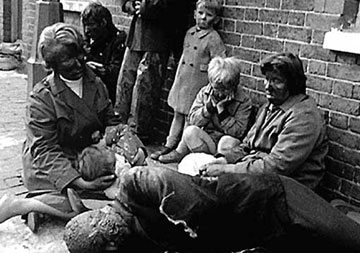 |
The War Game |
 Conservative agenda Conservative agenda
This single size and designed to trap: to capture and maintain the public's attention on long periods of time. It is organized for crear predetermined answers, which means that even before the public to view any movie or TV show of the single size, the producers already know how the public will react, or at least that's the intention. It is not allowed any public reaction that might be different from the early and packed.
The media, and probably many media scholars might argue that the use of a single size in this way is a practice widely accepted. But accepted by whom? Those who have discussed? And what do we know its impact?
Given the absolute magnitude and universality of the crisis in the media (and its effects on creative development and pluralistic film and television on the one hand, its harmful social consequences, political and civil trial on the human hand), the silence that reigns in public Links in Mavm themselves, and in the educational sphere, it is shocking.
The media crisis is not only related to the increased use of single size, but also with the agenda of Mavm: what the media choose to show on TV screens or to produce for film (or print to print) . With few exceptions (mainly in the print media), the agenda of the media is very conservative and based on national ideology (or lack thereof), and in the West requires the maintenance of neoliberal globalization.
Another aspect is the process of democratic Mavm to the public, and this affects every element involving decisions made by the media what to say / tell (or not) to the public (agenda), and how to structure the presentation (form) . The process involves every other aspect of the report: training of professionals, how they interact or communicate (or not) with the public (in public meetings, etc..), The share of their power, what sort of interaction and feedback allow viewers during or after the program, etc..
The use of the verb 'communicate' by Mavm should be alarm bells ringing. The term 'communication' means an exchange between two or more people. How can this be possible when one (or more) parts using a shape-coded language to impose a highly centralized and hierarchical relationship on the other? Especially when neither Mavm nor the educational system are prepared to reveal these codes or the real logic behind them.
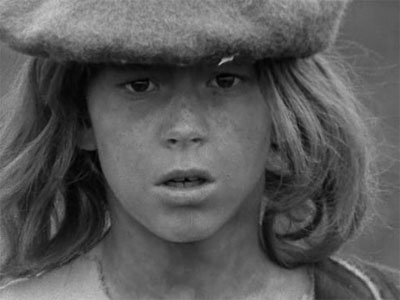 |
Culloden |
 The role of single size The role of single size
Today young people who aspire to enter the world of cinema and television should be subject to an educational system that stresses such as single size is crucial to their future as media professionals. They will invariably be taught the need for temporal format and time slot always decreasing in their work, usually an 'hour' corrupt in 40 minutes or less (the 'universal clock'), with the rest made up from advertising. They will be taught how to "promote" their projects to producers (one of the most envied and dangerous working practices of the new era). They will be indoctrinated with the need to succumb to the order existing media and imbued with the notion that "professionalism" means to impose the power of images to the public (= logic "impact").
Probably the kind of Mavm that has suffered most of the crisis and the imposition of a single size and mean what we call (or called) "Documentary."
Many documentaries have become circus full of tricks and visual impact explosive aggressive, with an ever-present host of the game (the director and narrator, often the same person) in front of the camera. The filmmaker can have certainly a genuine purpose, but almost invariably chokes work (and argument) in a form-language, aggressive, hierarchical and 'entertainment' means the single size.
Of course there are exceptions, which show us that there are absolutely different ways of working with the documentary, both shaped-language argument. Unfortunately, the existing media circus means that these films are rarely funded. And rarely seen by the public.
That many filmmakers and intellectuals of the media believe that an argument radical or a powerful theme in itself create a cinema 'alternative' is another paradox. In many cases it is only the content that can be considered as an alternative: a theme in itself is not radically challenge the primary problem of the hierarchy of form, process and structure. In fact, only confuses the true central point of focus and is one of the main reasons for the lack of development made over a certain limit of critical thinking on the role of Mavm.
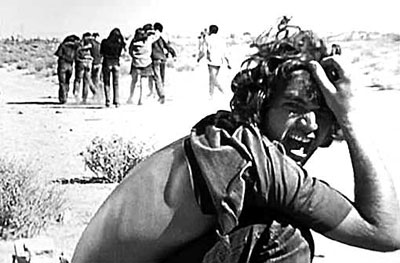 |
The Punishment Park |
In other words, is not just the visible content of programs or movies to be problematic: they are the way you work with time, space and pace, and the invisible process that is used to create a relationship with the public , the real focus of the media crisis. And here we return again to the role of a single size.
This practice launches many contradictions to the themes and claims of the filmmakers, the concept of "objectivity" and the concept of democracy, for which many documentary makers claim to fight. An example of this aspect of the crisis of the media are films by American director Michael Moore, whose works are representative of a broad range of documentary films in aggressive style that is now strongly drawn in commercial cinema.
Michael Moore would have said recently that he wants his audience to commit itself to democracy, which "jump on the bench and become active." The paradox here is that he uses a very hierarchical structural form to make 'committed' his audience.
The single size is just one of countless ways of combining images and sounds. Cinema is like a rainbow, and a small single size fragment in the vast spectrum of colors and shadows. The Mavm have usurped and magnified their use of this chip to Orwellian proportions, but I think the situation can be challenged. It must be, for the salvation of the planet.
New ways of interacting with the public should be initiated to develop alternative forms of engagement with the audiovisual media: forms and processes that move beyond the structures of a single size. The first step includes a holistic awareness of the many problems that accompany the average of the single size, not least the acceleration of the consumer society. The filmmaker should want to leave, at least to some degree, the power implicit in the use of media of a single size. Filmmakers, alternative distributors, cinema owners and art houses, media scholars should extend the debate over the value of production or intellectual pleasures included in the film showing. A new land is possible to widen the concept of creativity, the pleasure of producing a film, so involving the direct participation, criticism and the public in ways that have not existed.
 Peter Watkins Peter Watkins
(From Notes on the Media Crisis by Peter Watkins, lecture Felletin, France, in March 2010 and published in No. 23 of "Quaderns portàtils' of the Museu d'Art Contemporani de Barcelona. Translation and adaptation of Stephen Case)
See (and read) Watkins
The official website of Peter Watkins is http://pwatkins.mnsi.net (in English). For each film are also indicated the availability and references for permits projection. The site of Rebond to spread the film La Commune is www.rebond.org (in English and French).
The DVDs of many films Watkins, some with extra content and sottitoli in English and French, were published by the American Project X Distribution (www.projectxdistribution.com) and France's Doriane-Films (www.doriane-films.com). The British Film Institute has just published the blu-ray Privilege with extras and subtitles in English (http://filmstore.bfi.org.uk. All DVDs are on normal online bookshop (only foreigners).
Bibliography in Italian: Peter Watkins, Tales of Ordinary telemanipulation, in "Company of thoughts", Bologna, No. 7, December 1993, and Germany A. Duarte, The disappearance of the universal clock. Peter Watkins and audio-visual media, Milano, Mimesis, 2009. (in English). |
|

